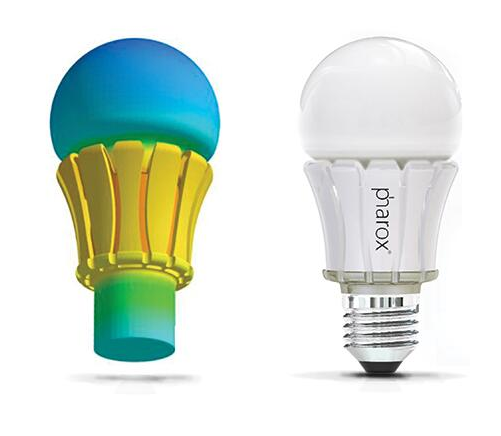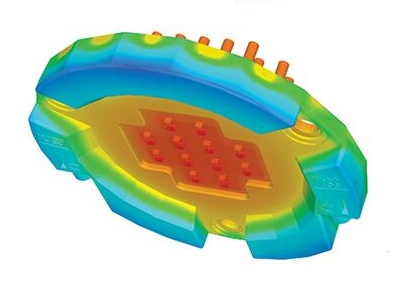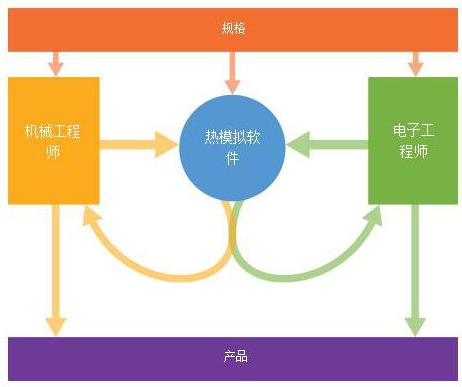In recent years, the LED lighting market has experienced explosive growth due to a number of factors, of which green legislation and environmental issues are the most important factors. LEDs are much more efficient than traditional light sources (such as incandescent lamps), are more environmentally friendly than fluorescent lamps, contain no mercury, and can adjust color and brightness. As a result, LEDs are used in a wide range of applications for professional, industrial and consumer applications. However, the design of solid-state lighting products is a complex multidisciplinary issue. Here, we will focus on heat dissipation challenges and how thermal simulation can help development teams develop reliable, form factor and performance products (Figure 1).

Figure 1. Thermal analog A lamp and finished product (Photo: Future Facilities Limited)
In fact, the lifetime of LED lamps (usually between 25,000 and 50,000 hours) is not fully realized, and the performance of solid-state lighting products sometimes degrades over time. Performance (quality and quantity of light output, lifetime, color maintenance, and other parameters) is closely related to the temperature within the luminaire or replacement lamp. For a given environment, how the design of the luminaire effectively dissipates the heat generated internally is directly related to temperature.
Design challenge
Two other related factors have also affected the long-term reliability of LED lighting: aluminum electrolytic capacitors for LED drive circuit energy storage, and market demand to drive lighting manufacturers to create more compact luminaires.
In addition to electromechanical components such as fans, aluminum electrolytic capacitors limit the useful life in many electronic circuits. The capacitor is an electrochemical device that is gradually used to reform the alumina dielectric layer during normal operation. The capacitor will eventually dry out with catastrophic consequences. At high temperatures, this process accelerates.
In professional applications, such as entertainment lighting, smaller lighting fixtures are needed, making it easier to transport and operate, and less awkward in use. In retrofit applications, from streetlights to household downlights, size and shape need to be kept within the limits defined by older lighting technologies. In the case of directional illumination, it is common to include an electronic driver circuit, and an LED emitter module and lens in the luminaire.
Adaptive drive circuit
The LED driver circuit needs to convert the AC grid voltage to a low DC voltage to drive the LEDs and ensure that the maximum output is achieved in an efficient manner. Despite the high efficiency, LED chips generate heat; components in the driver circuit, especially power transistors, generate heat. If all the heat-generating components are placed in a small space to meet the physical design constraints, the heat will be very fast, even exceeding the maximum 100 °C that the LED junction can withstand.
LED lamps challenge designers face is how all these things are on the available space while ensuring that the finished product temperature inside and outside the key point remains within an acceptable range. At this time, thermal simulation can work, especially throughout the design process. Figure 2 shows an example of a chip module with good heat dissipation under thermal simulation.


Figure 2. Thermal simulations show that these chip modules show good thermal management characteristics. (Photo: Future Facilities Limited)
The benefits of thermal simulation
In the past, most of the design and development work was based on the use of “rules of thumb†to thermally calculate the possible performance of a particular component, printed circuit board (PCB), or complete component. Since the design and development process of any electronic product is iterative, it must be repeated throughout the product development process. At each stage, design errors need to be corrected and even hot spots may be missed. Each change increases the time and cost of the project and increases the risk of losing time in the market.
Moreover, the accuracy of this method is relatively poor, and designers have to over-design thermal management. For example, this may mean using larger heat sinks, increasing the size and cost of the finished product, and may even mean using a fan without the need for a fan, greatly reducing the "mean time between failures" (MTBF) of the finished product. What is even more frightening is that after the finished product is produced, there is a heat problem, followed by warranty claims, product replacement, and damaged brand reputation.
As a result, thermal management enables engineers to design products that are smaller, more economical, perform better, and last longer. Thermal simulation makes iterative design faster, allowing you to experiment with a variety of thermal management options and ultimately reduce time-to-market.
Simulate during development
The earlier the thermal simulation is performed during the design process, the lower the risk of major design changes being made to overcome possible thermal problems. Throughout the project, electronics, mechanical, and thermal engineers need to work together to ensure that the thermal simulation results are taken into account during the design process and that the impact of design changes on thermal performance is fully recognized. Figure 3 depicts the interaction between team members with different subject backgrounds.

Figure 3. In order for the thermal simulation to be valuable, engineers need to work together. (Photo: Future Facilities Limited)
In the beginning, a very simple conceptual model - in which all electronic components are represented as a concentrated thermal block - can be used to determine if it is possible to cool the luminaire within the limits of the specification (Figure 4). The total power consumption, size of the product, the size of the heat sink, and the airflow of the fan (if used) represent all the information available at this stage.

Figure 4. (Photo: Future Facilities Limited)
In the next phase, when the initial product design has been established, the thermal modeling tool requires the following information:
· detailed information of the component and its location on the PCB;
· estimated consumption of the most important components;
• The size and outline of the lighting fixture housing.
After running the simulation, the temperature profile highlights where the component may exceed its maximum allowable operating temperature.
Input data affects results
The more accurate the input data, the more accurate the simulation. The results of the preliminary simulation can guide PCB designers and mechanical engineers to make changes that may benefit the thermal performance of the luminaire. As the design evolves, this process repeats again.
Before the prototype is produced, the final design proposed earlier should be simulated again. In order to ensure that the results of the simulation are accurate, more detailed information is needed. This includes:
The thermal model of the components in the luminaire, which can be obtained from the component manufacturer;
· 3D CAD model of the luminaire housing, which can be imported into the simulation tool in standard formats in various industries;
· PCB design for EDA software, which can be imported using industry standard formats such as IDF and IDX;
· Details of trace element copper in the PCB layer;
• information on the characteristics of the materials used in the luminaire;
· According to engineering calculations, the latest data on the internal device power consumption of the luminaire.
Once the prototype is complete, the development team verifies the accuracy of the simulation by measuring the physical temperature. When evaluating these data, it is important to consider the accuracy limits of the measuring equipment used. These may be thermocouples, on-chip sensors or infrared sensors, depending on the application.
Thermal simulation accuracy
Optimal thermal Solutions BV's thermal design specialist Norbert Engelberts used a thermal simulation tool to develop a range of LED lighting projects. The first is to design an LED lamp for the European market instead of the 60W incandescent E27 A-type lamp. The design goal is to achieve the lowest possible heat sink temperature with convection cooling to maximize lamp life. As the temperature increases, the operating life decreases. Thermal modeling was used to optimize the heat sink design, and when evaluating the final product, the simulation was found to be within 5% of the measured temperature.
The same accuracy occurred when designing downlights. The design goal is to determine the smallest heat sink that can be used while ensuring that the LED junction temperature remains within the limits of 100 °C. The overall difference between the measured temperature and the simulated temperature is only 4.6%.
Engelberts also used thermal models in the development of streetlights. The challenge here is to ensure effective thermal management within the IP66 sealed enclosure, the size and shape of which depends on the size and shape of the conventional bulb to be replaced. The weight of the lamp is a critical issue, so the heat sink needs to be kept to a minimum size without affecting the life of the product. From the initial design to the final design, the average temperature at each point in the lamp was reduced by 19%, and some points were reduced by 35%. The final product is only 13% heavier than conventional luminaires, but more reliable and energy efficient.
Telecom T Series Lead Acid Battery
Custom Lead Acid Battery,Telecom T Series Lead Acid Battery,2V 300Ah Battery,Valve Regulated Sealed Battery
Wolong Electric Group Zhejiang Dengta Power Source Co.,Ltd , https://www.wldtbattery.com